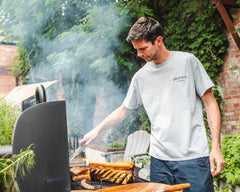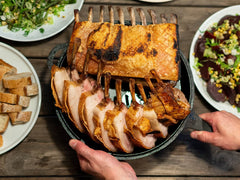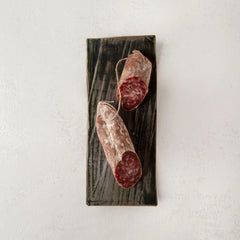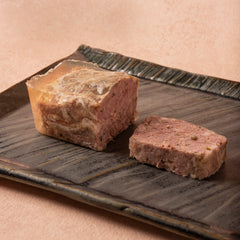Charcuterie boards are a culinary delight, and make for the best appetizer you can think of. While scrolling through your social media feeds, you will find several charcuterie board designs that will blow your mind. Although these designs seem complicated, you can assemble your own board effortlessly with a variety of ingredients such as terrine, mousse, cured meats, nuts, fruits, cheese and crackers depending on your taste.
In this article, we will show you how to make a selection of cured, cooked and smoked meats, pâté, and other key components to create a spectacular charcuterie board display for the pure pleasure of your guests.
Why are those Charcuterie Boards so popular?
Food lovers think of charcuterie as a harmonious blend of delicious meats and cheeses arranged in an aesthetically pleasing manner on a board. It is widely believed that charcuterie boards bring people together and foster a sense of conviviality, thus providing a simple, yet enjoyable gourmet experience.
From a culinary perspective, a charcuterie board concept combines several cured meats and presents them in various creative ways. The perfect charcuterie platter can feature a delicious selection of various items of different texture and style like soft cheese, blue cheese, creamy cheese, goat cheese, and cooked and cured meats, among other accompaniments as fresh or dried fruits, nuts, pickles, toasted bread or crackers.

You may have noticed that cheese and charcuterie platters have become a true trend on social media and some people have become masters at it and even gained the status of “charcuterie influencer“ like Marissa Mullen who has almost 300k followers on her instagram account @cheesebynumbers.
According to Ken Albala, a history professor with a focus on food at the University of the Pacific in California, the mass appeal of charcuterie on social media coincides with the rise of crafting and foodie cultures, paired with an inherently aesthetically pleasing nature. "For hundreds of years people have been doing cheese boards and charcuterie, but I think it has been part of the rise of the interest in do-it-yourself artisanal craft food," he said. "It's also very photographical, and a lot of food that is great is not. A plate of stew is just disgusting-looking on camera, but if you can arrange things in fun patterns it looks nice and that's why it's very Instagrammable."
In the end, the charcuterie board is very accessible to anyone. First it is a do it yourself activity and you do not need to have a lot of cooking skills to create the most exquisite board. It is a lot less intimidating than having to create a full course menu for your friends and family and you do not need a gourmet kitchen to elaborate the most beautiful platter. Finally, it gives you the opportunity to be very creative and to make it your own, especially if you or your guests have any dietary restrictions or allergies. Plus once the board is done, you can just enjoy your drink and chat with your loved ones while nibbling on it!
What are the things you need to create a charcuterie board?
You may have noticed that perfect charcuterie board ideas have several things in common. For one, charcuterie boards should have a perfect blend of 3 to 5 ingredients that are artfully arranged with colorfully decorated cheese knives and a medley of soft cheeses and meats to go with them. You’ll need a plethora of essentials to pull off the perfect charcuterie board!
The right Board or Plate
The first, and perhaps most important step, lies in selecting a charcuterie board, or platter, as the foundation of your charcuterie display. Common charcuterie board materials include marble, slate and wood, which are prevalent choices for making charcuterie boards due to their aesthetic appeal and sturdiness. You can choose a shape that suits your taste, although you should never forget that the shape of your charcuterie board influences your design. In essence, the shape of your board should be chosen with care.
A rectangular board, for example, tends to accommodate more cheese wedges than a square-shaped board. It is important to keep in mind that the larger your board, the more products you will need to make a charcuterie board.
The Cheeses
It would be best to visit a local cheese shop to purchase unique and high-quality cheeses. A fromagerie offers a diverse selection of cheeses, including hard cheese, soft cheese, blue cheese, out of the ordinary cheese, and many more. Ensure that you make a judicious selection of contrasting textures and flavors to diversify your platter. The variation of a cheese board allows your guests to sample a wide range of options. If you are unsure which type of cheese to obtain, asking the cheese specialist for pairing recommendations or best sellers would be the best course of action.
The Meats
A charcuterie board idea is never complete without the inclusion of an assortment of meats. Incorporating some thin slices of cured meats on your plate is the most desirable approach. You can either lay your cured meats flat on the cutting board, or alternatively, arrange them in loose rolls, thus facilitating the ease of self-service for your guests to cut themselves while using the serving board.
Furthermore, you must include spreadable meats like chicken or duck liver pâté. Other popular charcuterie meats that should be considered include pancetta, hard salami, mortadella, and prosciutto.
Crackers or Bread
Breadsticks, crackers and bread are other essential elements that should be incorporated into your charcuterie board. It is best to include some starchy accompaniments, especially if you have spreadable cheese, pâté or jam on your board. Although there are no strict rules or guidelines that dictate which biscuit options you can include, the best charcuterie board ideas usually incorporate two types of bread or crackers with varying flavors. If you are sensitive to gluten, it is best to substitute your regular crackers/bread with a gluten-free alternative, such as a nut-based option.
The side accompaniments
The inclusion of fruits and vegetables tend to add some much-needed freshness, color and vibrancy to your charcuterie board. These fresh fruit and vegetable options also provide a pleasing contrast to the rich, salty meats and cheeses typically found on those large plates. It is best to consider foods you can eat wholly or cut into thin slices. It is advisable to select and purchase in-season produce to obtain the best flavors for your charcuterie board. Do not forget about nuts and olives that can also give a beautiful look to your platter and a healthy option too!
Finally, adding small cups of olives or sour pickles like cornichon will complement each product well on your board. The acidity of the pickle will perfectly balance the fatness of the charcuterie. The dishes you use will determine how the charcuterie board will turn out. Utilizing small dishes, cups, and receptacles (like the ideas here) to anchor the arrangements. This provides a stable base for loose items, such as nuts, dips, and olives. Looking through your kitchen cabinet for small dishes, salt cellars, and perhaps some ramekins, can work wonders for your charcuterie board. Anything you have at your disposal in your kitchen may work out for your charcuterie board idea.

How to Build a Gorgeous Charcuterie Board
While several charcuterie board ideas can be found on the internet, some concepts can be quite complicated for a first-time charcuterie board creator. As a general rule of thumb, you have to first add some structural foundation to your board by including small dishes. Once the foundation is established, you may proceed to arrange your ingredients on the charcuterie board. Always start with the most prominent elements and progress to the smaller ones. Start with bigger elements such as hard cheeses and meats, and then add smaller ones, like fresh fruit, nuts and crackers to tuck them in between each larger element.
Conclusion
It is best to serve most charcuterie meats and cheeses at ambient temperature. Avoid leaving perishable food for more than two hours on the board, because they may spoil your charcuterie board and compromise its integrity. Keep a small portion of "refill" items (sliced meats and cheeses) in the refrigerator to help you restock your board on the go. Have fun and share your creations with us!








